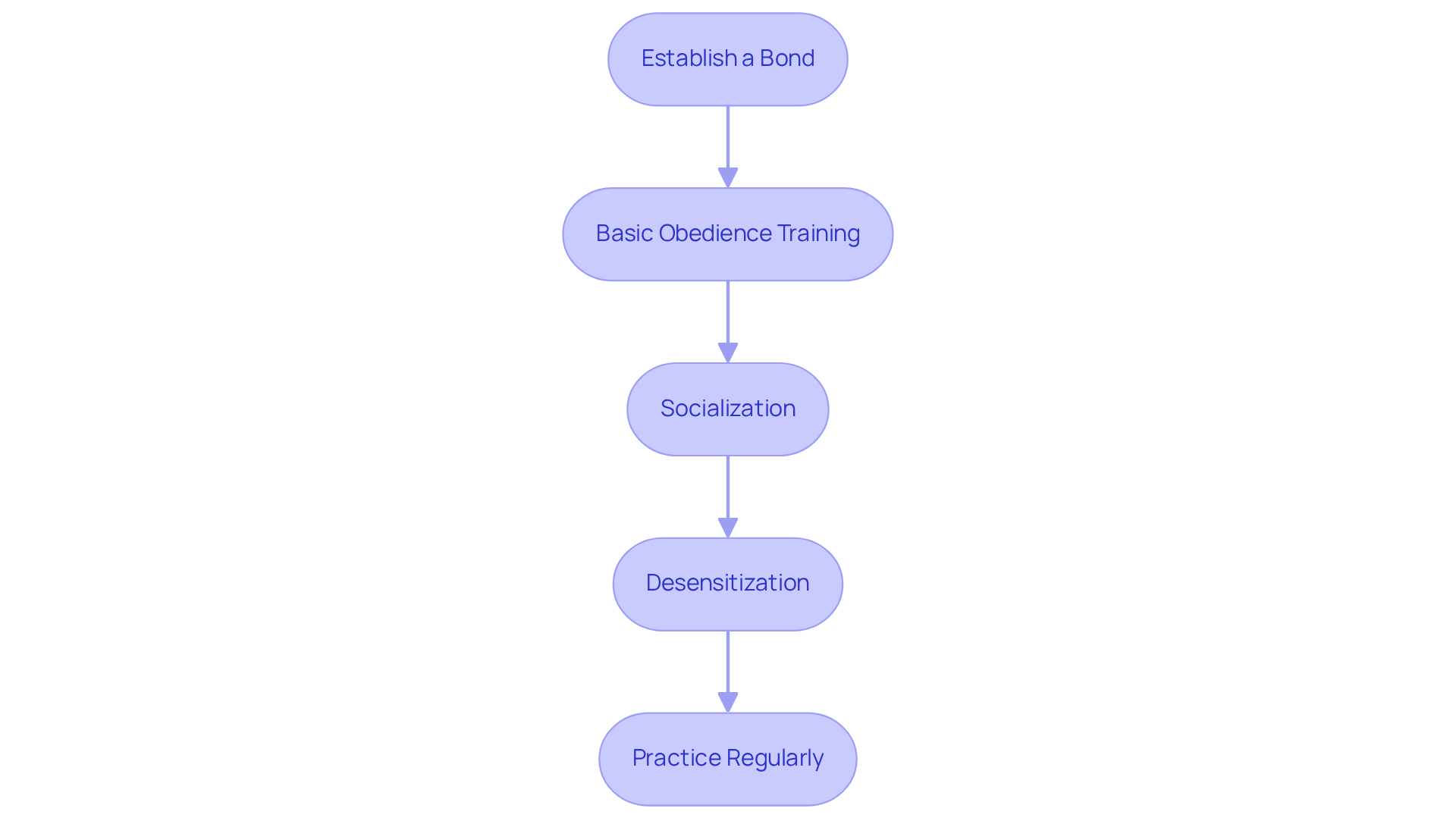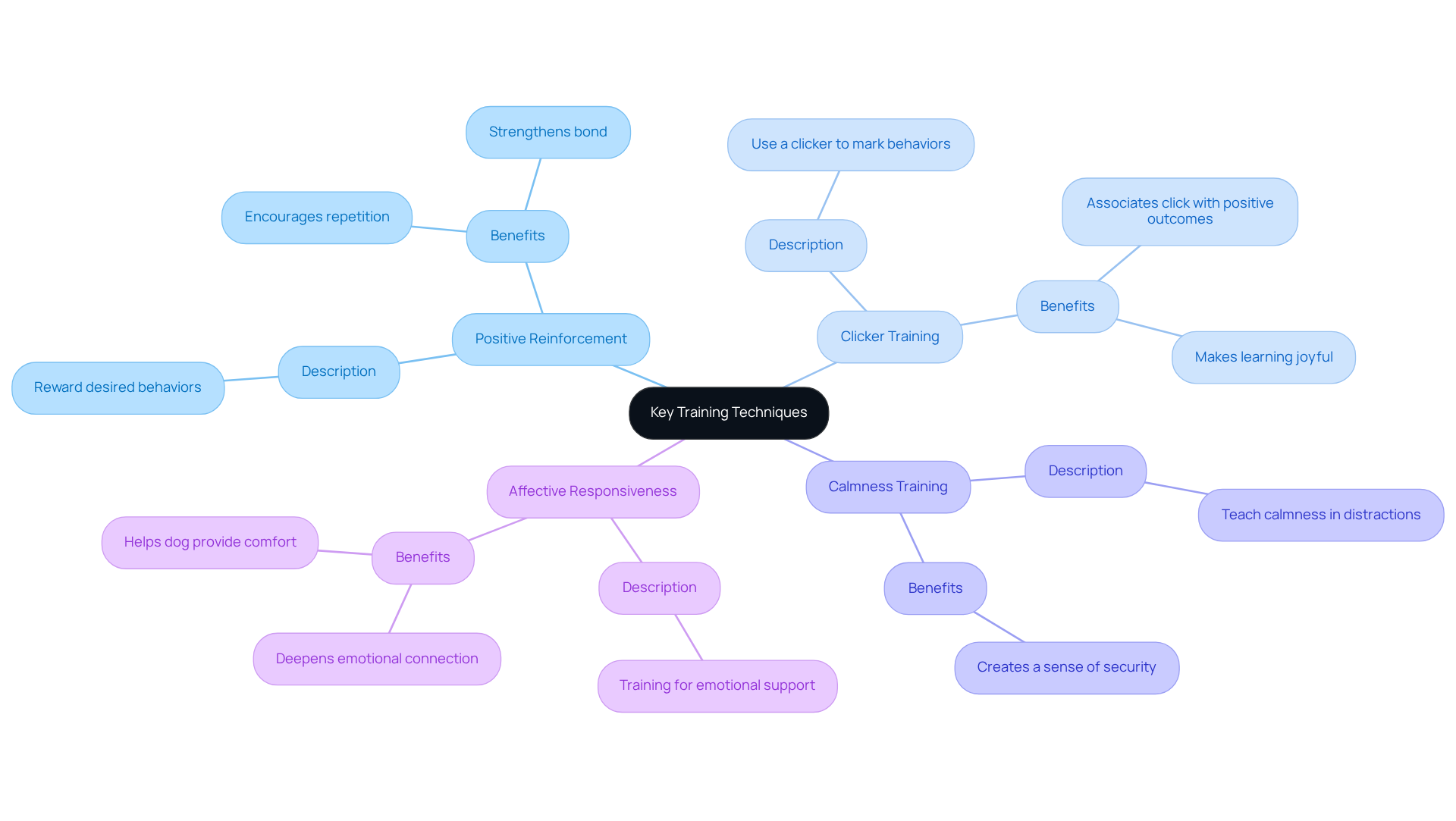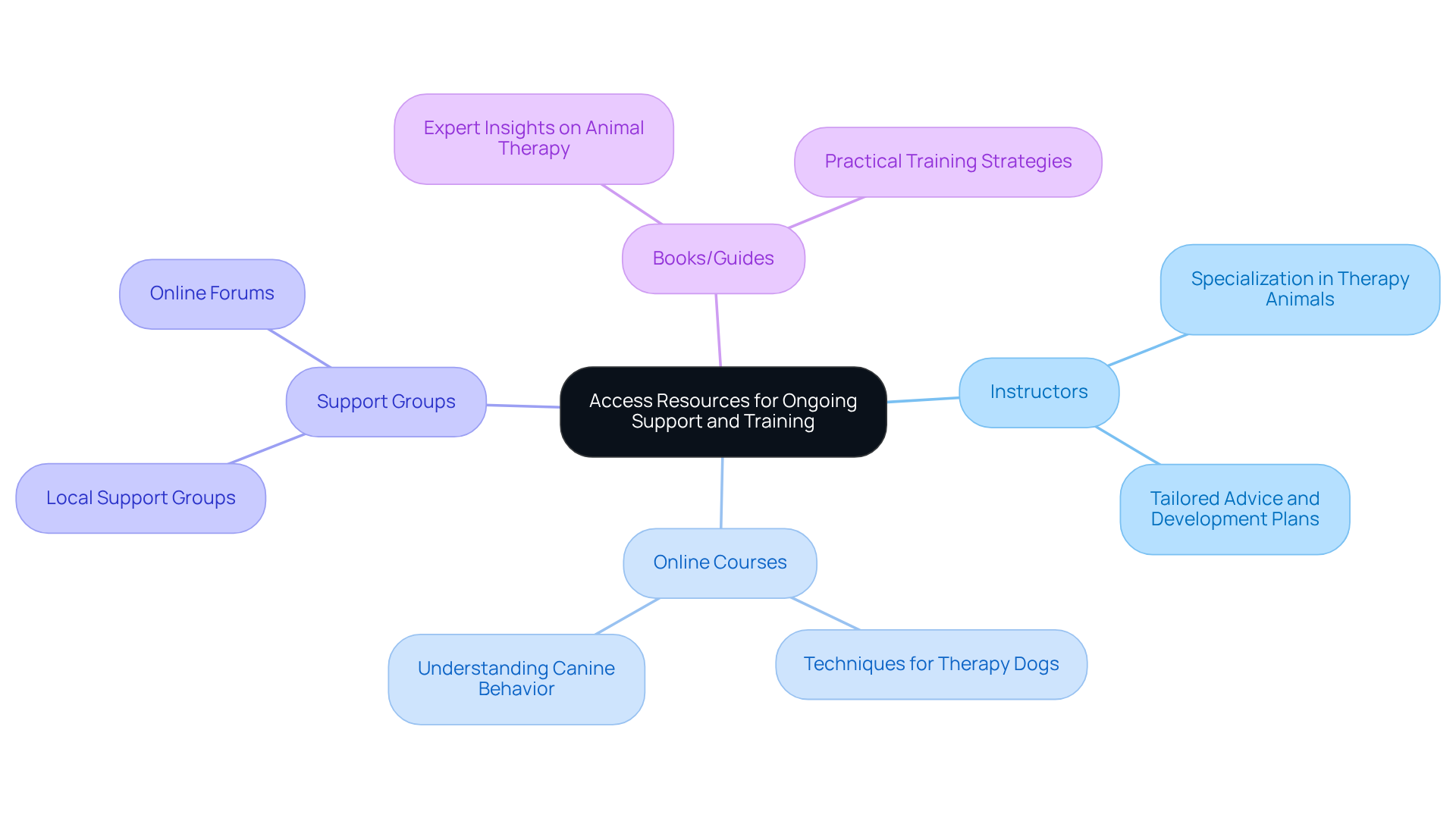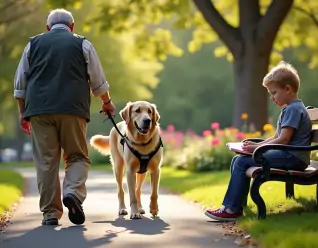

4 Steps for Effective Training for Emotional Support Dog
by Lena Park
Last updated: July 11, 2025
Verified and Approved by:
Angela Morris,
MSW, LCSW
Fact Checked

Overview
The article highlights four essential steps for effectively training an emotional support dog:
- Establishing a bond
- Basic obedience training
- Socialization
- Desensitization
These steps are vital, as they not only enhance the dog’s ability to offer comfort and support but also ensure adherence to legal standards. This compliance maximizes the therapeutic benefits of the human-animal bond, providing a nurturing presence that can significantly improve emotional well-being.
Introduction
Emotional support dogs have become essential companions for individuals navigating the complexities of mental health challenges. They offer comfort and stability just by being present. This article explores the vital steps for effectively training these remarkable animals, ensuring they are prepared to provide the support their owners need.
Yet, the journey of training an emotional support dog can present challenges. What techniques can truly cultivate the bond and responsiveness necessary for these dogs to thrive in their roles? As we delve deeper, let’s reflect on the emotional hurdles faced by those seeking support and how these incredible animals can make a difference.
Understand the Role of Emotional Support Dogs
Therapeutic animals play a vital role in providing comfort and companionship to those grappling with mental or psychological challenges. Unlike assistance dogs, which are specifically trained to perform tasks for individuals with disabilities, therapy animals primarily offer solace through their mere presence. This distinction underscores the importance of these animals being calm, affectionate, and attuned to their owner’s emotions. Mental health professionals highlight that the bond between humans and their pets can significantly ease symptoms of anxiety and depression. Studies reveal that interactions with companion animals can lead to remarkable improvements in mental well-being. In fact, a survey found that 86% of pet owners reported a positive impact on their mental health, showcasing the therapeutic benefits of having these loving companions.
Moreover, therapy animals are protected by regulations such as the Fair Housing Act, which allows them to reside in housing that typically prohibits pets. This legal framework emphasizes the necessity for proper training for emotional support dogs to ensure these animals behave appropriately in various environments, thus enabling their owners to access essential support. Training for emotional support dogs not only enhances the dog’s ability to provide comfort but also ensures compliance with legal standards, making it a crucial component of the comfort dog experience.
At Wellness Wag, we simplify the process of obtaining legitimate ESA letters through personalized consultations with licensed medical professionals. Our clients enjoy a seamless experience, receiving expertly crafted ESA letters that hold legal recognition within 24 hours of their consultation. This not only streamlines the process but also ensures that clients can fully benefit from the legal protections afforded to assistance animals. Case studies indicate that all participants in a 2020 survey reported an improvement in their quality of life due to their support animals, further emphasizing the profound impact these dogs can have on mental health.
Follow a Step-by-Step Training Process
-
Establish a Bond: Begin by dedicating quality time to your dog, nurturing trust and a strong emotional connection. This bond is essential for effective instruction and enhances your dog’s responsiveness to commands. As Susana Bradford observes, ‘Many ESA owners are involved in training for emotional support dog their own pets.’ With your commitment to teaching good manners, there’s no need to hire a professional trainer for training for emotional support dog.
-
Basic Obedience Training: Focus on teaching fundamental commands like ‘sit,’ ‘stay,’ and ‘come.’ Utilize positive reinforcement techniques, such as treats and praise, to motivate your dog and encourage good behavior. Aim for training sessions lasting about 5-10 minutes daily to maintain engagement and effectiveness. Remember, training for emotional support dog involves basic obedience training that can take several weeks, depending on your dog’s age and temperament.
-
Socialization: Introduce your dog to a variety of environments, people, and other animals. This exposure helps them adapt and reduces anxiety in unfamiliar situations, promoting a well-adjusted demeanor. Regular social interaction is vital for therapy dogs to thrive in diverse environments.
-
Desensitization: Gradually expose your dog to scenarios that may trigger anxiety or stress for you. This process involves training for emotional support dog, teaching them to remain calm and supportive during challenging moments, which reinforces their role as an emotional support animal. Techniques such as gradual exposure and positive reinforcement can be effective in this learning phase.
-
Practice Regularly: Consistency is crucial in preparation. Schedule regular sessions to reinforce learned behaviors and skills, ensuring your dog remains responsive and well-behaved in various situations. Incorporating specific practice techniques, like using the ‘leave it’ command, can help manage distractions and enhance overall behavior.

Focus on Key Training Techniques and Skills
Key training techniques include:
-
Positive Reinforcement: Reward your dog for desired behaviors to encourage repetition. This method not only fosters a positive learning environment but also strengthens the bond between you and your furry friend.
-
Clicker Training: Use a clicker to mark desired behaviors, followed by a reward. This technique helps your dog associate the click sound with positive outcomes, making learning a joyful experience for both of you.
-
Calmness Training: Teach your dog to remain calm in various situations. You can practice this by gently exposing them to distractions while rewarding calm behavior, creating a sense of security in your dog.
-
Affective Responsiveness: Engage in training for emotional support dog to help your dog recognize and respond to your feelings. Training for emotional support dog involves simulating scenarios where you may feel anxious or upset, and rewarding your dog for providing comfort, which can deepen your emotional connection and help your dog become a true source of support.

Access Resources for Ongoing Support and Training
When seeking support, it’s essential to find instructors who specialize in therapy animals. These professionals can provide tailored advice and development plans that cater to your unique needs. Their expertise often includes insights into the rigorous training methods that service animals undergo, which can significantly inform your approach to training a therapy animal. Remember, assistance animals are trained to perform specific tasks that help their handlers manage disabilities, such as guiding individuals with visual impairments or alerting those who are deaf to sounds. Additionally, obtaining certification or documentation from reputable organizations can enhance the credibility of your therapy animal, similar to the standards set for service animals.
There are numerous platforms offering online courses focused on canine behavior, including dedicated sections for therapy dogs. These classes can shed light on effective techniques and the unique requirements of assistance animals, providing you with valuable knowledge.
Engaging with online forums or local support groups for emotional support animal owners can also be incredibly beneficial. Sharing experiences and advice with others who understand your journey can help you navigate the development process more smoothly.
Lastly, consider exploring books and guides written by experts in animal therapy and development. These resources can provide deeper insights and practical strategies for effective training for emotional support dogs, ensuring that your dog is well-equipped to assist you in your journey.

Conclusion
Emotional support dogs play an essential role in enhancing the mental well-being of their owners, providing companionship and comfort that can significantly alleviate symptoms of anxiety and depression. It is crucial to understand their unique function compared to other therapy animals, as this underscores the importance of proper training. Such training not only ensures these dogs deliver the necessary emotional support but also equips them to navigate various environments while enjoying legal protections.
The article outlines a thoughtful four-step process for training emotional support dogs:
- Building a strong bond
- Essential obedience training
- Socialization
- Desensitization
Key techniques like positive reinforcement and calmness training are highlighted, emphasizing the significance of consistency and engagement throughout the training journey. Moreover, accessing ongoing resources and support can further enhance training effectiveness, allowing owners to nurture a well-adjusted and responsive emotional support animal.
Ultimately, investing time and effort into training an emotional support dog is not merely beneficial for the animal; it also transforms the owner’s experience. By fostering a deep connection and equipping the dog with essential skills, individuals can unlock the full potential of their emotional support dog, leading to a more fulfilling and supportive relationship. Engaging with available resources and communities can provide further guidance and encouragement, making the journey of training an emotional support dog both rewarding and impactful.
Frequently Asked Questions
What is the role of emotional support dogs?
Emotional support dogs provide comfort and companionship to individuals facing mental or psychological challenges. Unlike assistance dogs, they are not specifically trained to perform tasks but offer solace through their presence.
How do emotional support dogs differ from assistance dogs?
Emotional support dogs primarily offer emotional comfort, while assistance dogs are trained to perform specific tasks for individuals with disabilities.
What are the benefits of having an emotional support dog?
The bond between humans and their pets can significantly alleviate symptoms of anxiety and depression. Studies show that interactions with companion animals lead to improvements in mental well-being, with 86% of pet owners reporting a positive impact on their mental health.
Are emotional support animals protected by law?
Yes, emotional support animals are protected by regulations such as the Fair Housing Act, allowing them to live in housing that typically prohibits pets.
Why is training important for emotional support dogs?
Proper training is essential for emotional support dogs to ensure they behave appropriately in various environments, which helps their owners access necessary support and comply with legal standards.
How can one obtain a legitimate ESA letter?
At Wellness Wag, individuals can obtain legitimate ESA letters through personalized consultations with licensed medical professionals, receiving expertly crafted letters that are legally recognized within 24 hours of their consultation.
What impact do support animals have on quality of life?
Case studies indicate that participants in a 2020 survey reported an improvement in their quality of life due to their support animals, highlighting the significant positive effects these dogs can have on mental health.
Certify Your Emotional Support Animal Today

Why You Can Rely on Us?
At Wellness Wag, we believe your pet deserves care rooted in both science and compassion. Each article is carefully researched, written in clear language for pet owners, and then reviewed by qualified professionals to ensure the information is evidence-based, current, and practical for real-life care. Our goal is to help you feel confident in making informed decisions about your pet’s health and well-being.
Reviewed by
Angela Morris, MSW, LCSW
Angela is a licensed clinical social worker with 20 years of experience in patient advocacy and community mental health. She has assisted numerous clients with ESA evaluations and brings a deep understanding of disability accommodations, ensuring that all information is accurate, supportive, and practical.

Written by :
Lena Park
Last Updated :
July 11, 2025












